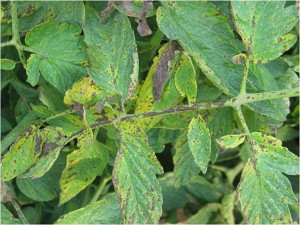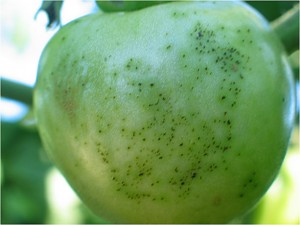What Is It? | Facts in Depth | For the Professional Diagnostician
Tomato Diseases | Bacterial Speck Fact Sheets
Bacterial Speck of Tomato
Identification
Seedlings:
- Infections are rare and cannot be distinguished from those caused by bacterial spot.
Plants:
- Greasy water-soaked spots on leaflets
- Leaf spots are brownish black and initially surrounded by yellow halos
- Spots increase in size to form large irregular dead spots
- Spots may also appear on stems
- Severe infections may cause the plant to lose its leaves
Fruit:
- Black sunken stippling appears early on green fruit
- Spots are small (<1/16 inch) and look like “pin-points” or “specks” on the fruit
- Spots are superficial and can be easily scraped off the fruit surface with a fingernail



Favorable Environmental Conditions
- Cool temperatures (64-75 °F)
- High moisture
- High relative humidity
Often Confused With
- Bacterial Spot
- Early Blight

Scouting Notes
- The pathogen is most active from the time of transplanting through to harvest.
- Foliar symptoms of bacterial spot and speck are identical.
- Fruit symptoms are diagnostic, based on spot size, appearance and texture.
- Spots are superficial and can be easily scraped off the fruit surface with a fingernail
- Disease progression is slowed during hot weather
- Plants in the field should be monitored weekly and suspect plants should be sampled and submitted for plant disease diagnosis.
